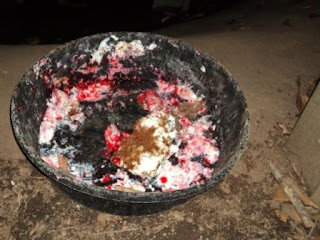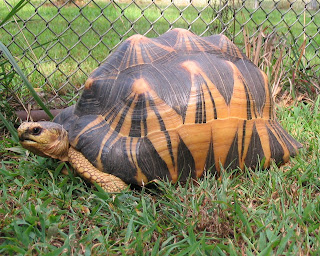Wow. I happened to check out the blog last week, and realized it has been a little while since any of us posted anything here! We have been a little busy lately: doing a percentage night fundraiser at Barberito's restaurant, renovating the Reptile House, planning the Bear Birthday Party, and much much more!
This post will be a little long, and more informational, but it will be heavy on the pictures. I hope it gets you interested in what it talks about.
The organization known as Partners in Amphibian and Reptile Conservation (PARC), in concert with other turtle conservation groups, has decided to make 2011 the Year of the Turtle.
Here is why (quote borrowed from
www.parcplace.org/yearoftheturtle.htm):
"Turtles are disappearing from the planet faster than any other group of animal. Today, nearly 50% of turtle species are identified as threatened with extinction. However, it’s not too late for our turtle heritage to be salvaged. The United States has more endemic turtle species than anywhere on Earth; a turtle biodiversity hotspot. Our careful stewardship can preserve the rare species and keep ‘common species common.’ "
Bear Hollow Zoo is going to participate in the Year of the Turtle as well. We will be doing a turtle-themed program each month of the year (we kicked off our turtle programs with one this last Saturday, January 29....there is another one planned for Feb 26). In addition, our annual Wildlife Art Contest will showcase only turtles this year, and Zoo Day will have a turle focus as well.
This Blog is just to show the diversity of turtles around the world, and just to show how lucky we are to get to have them share the earth with us!
Enjoy!
Green sea turtles (
Chelonia mydas) are so named not because they are green (this one sure isn't!), but because of the color of the fat inside their bodies.
Loggerhead sea turtles (
Caretta caretta) are regular nesters on Georgia's beaches. You may get lucky some summer night and get to see a female crawling ashore to nest, or see the babies emerging from their eggs and scrambling towards the sea.
Speaking of Georgia, did you know that the Gopher Tortoise (Gopherus polyphemus) is our very own State Reptile? Bonus points: what is the State Amphibian? State Fossil?
Aldabra tortoises (Aldabrachelys gigantea) are the second largest species of tortoise in the world. Big adult males have a shell that gets to be nearly four feet long, and weigh around 600 pounds!
Here's a juvenile Aldabra, about the size of a basketball:
And here's an adult male Aldabra (with a bit of banana on it's snout):
Leopard tortoises (
Stigmochelys pardalis babcocki) are so named because they develop spots on their shell that are reminiscent of leopard skin. Babies hatch out with dark colored shells and a single large spot on each scute.
But soon, their pattern changes and they begin to look more like this:
And here is how that camoflauge comes into play:
The Indian Star tortoise (
Geochelone elegans) also has a very boldy patterned shell. It comes from areas of open forests and grasslands in India. It is one of the smaller tortoise species, with males only reaching about 6 inches. Females are actually a bit bigger, reaching up to 11 inches.
Radiated tortoises (
Astrochelys radiata) come from the island of Madagascar, off the southeastern coast of Africa. For a long time it was a
fady (or taboo) to bother these tortoises in any way, but now locals in Madagascar are eating them by the thousands each year.
Like the star tortoises, radiateds also have a brightly patterned shell. When out in the open, these two species stand out pretty well. But concealed among dried grasses, you can see how their coloration helps to disguise them.
And again: Those wonderful radiating yellow lines are remarkable camoflauge!
A close cousin to the radiated is the Ploughshare tortoise (
Astrochelys yniphora), or Angonoka, also from Madagascar. These tortoises are named because of that giant gular scute that comes out from below their neck. Sometimes it is so big that the tortoises have trouble eating!
Back on the African mainland, this is the largest tortoise there, the African Spurred Tortoise (
Centrochelys sulcata). These tortoises dig immense burrows- as can be seen behind this one. That is how they survive in the harsh desert environments they live in naturally.
One of the smaller African species is the Pancake tortoise,
Malacochersus tornieri. They have a very soft, flexible shell that allows them to squeeze into cracks and crevices between
kopjes (rock piles) in Tanzania and Kenya.
And here is one doing what pancake tortoises do best:
Wood turtles (Glyptemys insculpta) live in the northern and northeastern parts of the US. They can be found wandering around in cold, rocky creeks as well as deep in the forest. They have a peculiar behavior called 'worm stomping' where they thump the ground repeatedly, making the worms believe it is raining and causing them to climb above the surface.
Another creek and river dweller, but this time in the southern portion of the US, is the Alligator snapping turtle,
Macrochelys temminckii. These are the largest freshwater turtles in the US, growing in size to almost 250 pounds. The alligator snappers (or loggerheads, not to be confused with the loggerhead sea turtle) have a pink, worm-like piece of flesh on their tongue that they can wiggle around to attract fish in for a quick bite to eat. That pun was definitely intended.....
Another creek dweller, and a cousin to the snapping turtles, the Chinese Bigheaded turtles (
Platysternon megacephalum) need very cold, very fast flowing water to survive. They live in mountain streams in China, Vietnam, Myanmar and other countries in that region. They are exceptional climbers and scale waterfalls and trees with the help of a prehensile tail.
The Malayan Snail-eating turtle (
Malayemys subtrijuga) is a very pretty, and often overlooked species. They come from ponds and slow moving creeks with mucky bottoms and lots of vegetation, where they can find their favorite food: snails!
A very distinct group of turtles is the softshell turtles, in this case, a hatchling Gulf Coast Spiny softshell,
Apalone spinifera aspera. These turtles are very flat, and true to their name, have a soft skin-covered shell. They also have very long necks and a snorkel-like nose that allows them to remain hidden under the sand or mud in shallow water, but stretch up and breathe. For size comparison, this egg is about the size of a very large grape.
Finally (for today), the Spotted turtle (
Clemmys guttata) is one of the smallest turtles in North America. It lives in boggy or mucky places in the East. One of the neatest things about spotted turtles is the males and females are different colors. Males tend to have darker skin on their heads and legs, and have black eyes. Females have a wonderful coral colored 'lipstick' and pretty brown eyes. The two pictures below are of a female.
We'll do more posts like these to celebrate the Year of the Turtle. For more information on our upcoming programs, please give us a call (706.613.3616 x22) or check out our Facebook page.
To learn more about our Turtle Art Contest, please call us up, stop by the Zoo, or email us at
bearhollowzoo@gmail.com
p.s.- the Georgia State Amphibian is the Green Treefrog, and the State Fossil is the (Megalodon) shark tooth. Did you get those right?
Posted by Berkeley









































